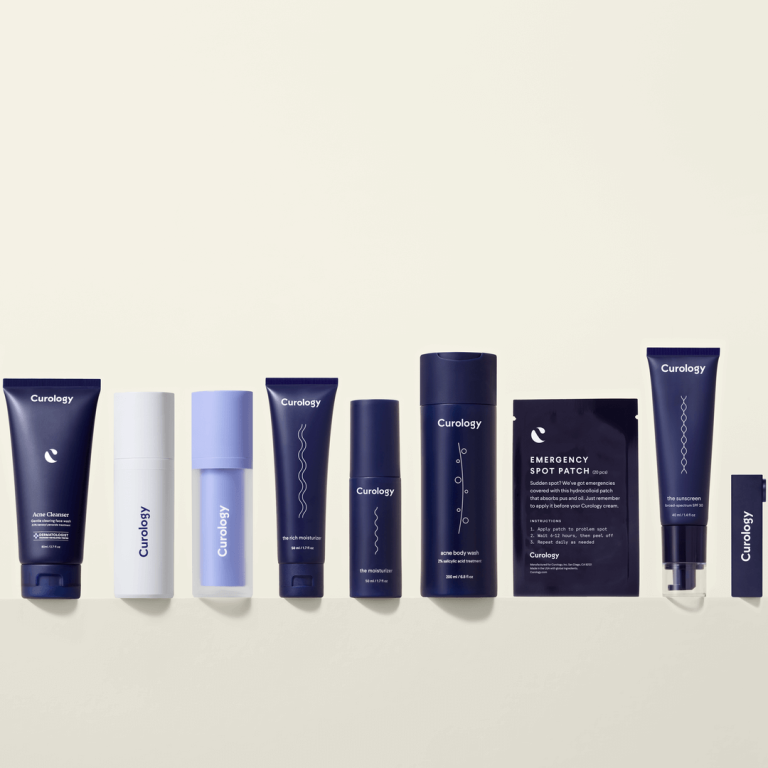How it works:
Share your skin goals and snap selfies
Your dermatology provider prescribes your formula
Apply nightly for happy, healthy skin
How it works:
How it works:
Share your skin goals and snap selfies
Your dermatology provider prescribes your formula
Apply nightly for happy, healthy skin
How it works:
Ask an expert: What is seborrheic dermatitis?
Seborrheic dermatitis is a more severe form of dandruff—here’s how to tell the difference between the two.



Here at Curology, we currently focus on diagnosing and treating acne, rosacea, and anti-aging concerns. We do not treat seborrheic dermatitis. This article is for information purposes only.
For most people, dry, flaky skin on the scalp usually means one thing: dandruff. But what if you’re seeing these greasy flakes on your body?
Seborrheic dermatitis is an inflammatory skin disorder that may affect the scalp and other areas of the body where there are highly active sebaceous glands that produce natural oils. Seborrheic dermatitis and dandruff share many features, but their location and severity are different.¹ Here we’ll tell you more about seborrheic dermatitis, its potential causes and symptoms, and possible treatments.
What is seborrheic dermatitis?
Seborrheic dermatitis is a common inflammatory skin condition characterized by flaky, scaly skin. It typically appears on areas of the body with concentrated sebaceous glands, such as the body folds, face, and scalp. Dealing with seborrheic dermatitis can be a hassle, but the good news is it’s not contagious.²
Both seborrheic dermatitis and dandruff can be caused by a combination of three factors: the skin’s sebum (especially in newborns), microbial effects (primarily by Malassezia yeasts), and individual risk factors, which we’ll discuss in a bit.³
Seborrheic dermatitis vs. dandruff
Telling the difference between seborrheic dermatitis and dandruff isn’t always easy because the symptoms are so similar, though location and severity can give us a clue! Dandruff is only seen on the scalp and symptoms include itchy and flaking skin, but inflammation is not usually involved. Although seborrheic dermatitis also includes itchy and flaking skin, two key differences are inflammation and its occurrence in other areas of the body—not just on the scalp.⁴
Symptoms of seborrheic dermatitis
Although seborrheic dermatitis affects all ethnic groups, in the skin of color (the medical term used for skin with more melanin/pigment), seborrheic dermatitis can look pink, slightly purple, or lighter than the surrounding skin. In lighter skin tones, it tends to appear as a red, raised rash. Seborrheic dermatitis symptoms may include the following:⁵
Flaking skin
Patches of white or yellow scales that may be greasy or dry
Itching
Inflammation (swelling and redness)
If you think you may be experiencing seborrheic dermatitis symptoms, our experts suggest seeing a licensed dermatologist or healthcare provider for an accurate diagnosis.

Who gets seborrheic dermatitis?
Although people of any age can be affected by seborrheic dermatitis, it has been found to be more prevalent during two periods of life. The first peak happens during the first three months of life with a dropoff during adolescence. The second peak tends to happen after age 30 and goes through periods of relapses and remissions.⁶
In babies, seborrheic dermatitis usually appears on the scalp and is called “cradle cap.” The condition is also common in adults over 50, and several studies have found that many adults over 65 live with seborrheic dermatitis.⁷
Research shows that seborrheic dermatitis can affect all ethnic groups in all regions globally, and it’s more common in males. The worldwide prevalence of seborrheic dermatitis is around 5%. One risk factor for developing seborrheic dermatitis is increased sebaceous gland activity.⁸
What causes seborrheic dermatitis?
Seborrheic dermatitis flare-ups may occur in response to various triggers that vary between individuals. Research also shows that the skin changes associated with seborrheic dermatitis may result from an immune response to Malassezia yeast, a common skin organism.⁹ Risk factors for the development of this skin condition include the following:¹⁰
Neurological and psychiatric conditions: Neurological and psychiatric conditions may put one at a higher risk of developing seborrheic dermatitis. These conditions include Parkinson’s disease, Alzheimer’s, major depression, stroke, and autonomic dysfunction.
Immunodeficiency: Those who develop seborrheic dermatitis may have a history of lymphoma, HIV/AIDS, or a kidney transplant.
Exposure to specific drug treatments: Dopamine antagonists, immunosuppressants, psoralen/PUVA, and lithium may increase the risk of developing seborrheic dermatitis.
Low ambient humidity or temperature: Cold, dry weather may trigger seborrheic dermatitis.
Malassezia: An impaired immune reaction to Malassezia, a fungus that lives on the skin, may contribute to the development of seborrheic dermatitis.
Seborrheic dermatitis treatment
The treatment of seborrheic dermatitis depends on the patient’s age and the severity of the condition.¹¹ However, treatment with topical antifungals, such as topical ketoconazole, is often the main treatment for seborrheic dermatitis of the face and body. Anti-inflammatory agents, such as topical corticosteroids and calcineurin inhibitors, are also used, but using them for long periods is not recommended due to possible side effects.¹²
A healthcare provider may instead prescribe an over-the-counter medicated shampoo for seborrheic dermatitis on the scalp.¹³ It may also be treated with oral medications, including itraconazole, fluconazole, and terbinafine.¹⁴
Curology is here for you

If you think you have seborrheic dermatitis, seek help from an in-person medical provider. But if you’re struggling with other common skin conditions, such as acne, signs of aging, hyperpigmentation, or rosacea, we’re here for you. Our licensed dermatology providers can treat these common concerns.
We want to help you tackle your skincare concerns and achieve your skin goals. That’s why Curology patients are paired with an in-house dermatology provider who will prescribe a personalized formula with a mix of three active, clinically researched ingredients for their specific skin concerns.*
Our full line of skin care products will complete your routine. All Curology products are designed by dermatology providers to be non-comedogenic, dye-free, and paraben-free. They’re made to keep your skin happy and healthy. The best part? Your subscription includes additional products recommended by your dermatology provider, such as our cleanser, moisturizer, and sunscreen.
FAQs
Seborrheic dermatitis is a chronic condition,¹⁵ so curing it completely may not be possible. However, in addition to the antifungal and anti-inflammatories mentioned above, good general skin care is essential to treating it. Avoid any irritating soap in favor of something more gentle, and always moisturize.
Additional treatment options typically include keratolytic, anti-inflammatories, and medications to reduce itching on the affected skin. Research shows that topical 1-2% ketoconazole, 1% ciclopirox, zinc pyrithione, and 1% hydrocortisone may be effective.
You can also try a medicated shampoo with varying combinations of pine or coal tar, salicylic acid, sulfur, and/or sulfacetamide. Let the shampoo sit for 5-10 minutes before rinsing off.¹⁶ Some of these shampoos are available over the counter, and some are by prescription.
Skin affected by seborrheic dermatitis often appears as scaly, flaky skin. The skin may be greasy or dry, ranging in color from yellow to white, and is likely itchy and inflamed. Although dandruff shares symptoms with seborrheic dermatitis—such as dry, flaky skin—dandruff is typically not inflamed and is only seen on the scalp.
Unfortunately, seborrheic dermatitis is a chronic skin disorder, and many people will experience relapses and remissions throughout their lives. Although it’s very controllable, it’s not curable.¹⁷
P.S. We did the homework so you don’t have to:
Borda, L.J., Wikramanayake, T.C. Seborrheic Dermatitis and Dandruff: A Comprehensive Review. J Clin Investig Dermatol. (2015).
Tucker, D., Masood, S. Seborrheic Dermatitis. StatPearls. (2022).
Gupta, A., et al. Three major facets of seborrheic dermatitis and their treatment. Journal of the American Academy of Dermatology. (2005).
Borda, L.J., Wikramanayake, T.C. Seborrheic Dermatitis and Dandruff: A Comprehensive Review. J Clin Investig Dermatol. Ibid.
Ludmann, P. Seborrheic dermatitis: Overview. American Academy of Dermatology. (2022).
Tucker, D., Masood, S. Seborrheic Dermatitis. StatPearls. Ibid.
Ludmann, P. Seborrheic dermatitis: Overview. American Academy of Dermatology. (2022).
Tucker, D., Masood, S. Seborrheic Dermatitis. StatPearls. Ibid.
Clark, G.W., et al. Diagnosis and treatment of seborrheic dermatitis. Am Fam Physician. (2015).
Tucker, D., Masood, S. Seborrheic Dermatitis. StatPearls. Ibid.
Tucker, D., Masood, S. Seborrheic Dermatitis. StatPearls. Ibid.
Clark, G.W., et al. Diagnosis and treatment of seborrheic dermatitis. Am Fam Physician. Ibid.
Clark, G.W., et al. Diagnosis and treatment of seborrheic dermatitis. Am Fam Physician. Ibid.
Tucker, D., Masood, S. Seborrheic Dermatitis. StatPearls. Ibid.
Clark, G.W., et al. Diagnosis and treatment of seborrheic dermatitis. Am Fam Physician. Ibid.
Tucker, D., Masood, S. Seborrheic Dermatitis. StatPearls. Ibid.
Tucker, D., Masood, S. Seborrheic Dermatitis. StatPearls. Ibid.
Laura Phelan is a board-certified Family Nurse Practitioner at Curology. She earned her Masters of Science in Nursing at Benedictine University and went on to get her post-master’s certificate as a Family Nurse Practitioner at the University of Cincinnati.
* Subject to consultation. Subscription is required. Results may vary.

Curology Team

Laura Phelan, NP-C